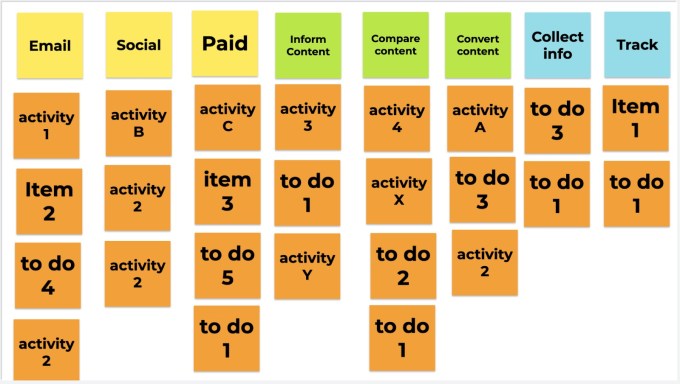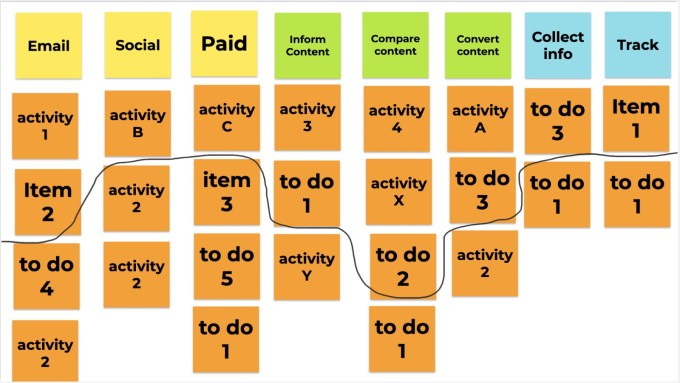Andrea Fryrear
Old-school approaches to marketing were often described as “spray and pray.” Marketers would launch a massive campaign in as many places as possible and hope that something worked.
More customers would show up, so it would appear that something had in fact worked.
But nobody could be sure exactly what that something was.
When we can’t predict what will have an impact, we need campaigns that cover all the bases, and those campaigns are consequently huge. They take a long time to create, are expensive to launch and come chock full of risk.
If a spray-and-pray campaign is a total failure (and we don’t have to go far to find examples of those), it’s quite possible an entire year’s worth of marketing budget has just been wasted.
Instead, marketers need to take a page from lean product development and begin creating Minimum Viable Campaigns (MVCs). Rather than wait until a massive multichannel launch is perfect, we can incrementally release a series of smaller, targeted, data-driven campaigns.
Over time these MVCs coalesce to look and act much like a Big Bang-style campaign from the spray-and-pray days, but they’ve done so in a much more data-driven and less risky way.
What exactly is an MVC?
Just as with a Minimum Viable Product (MVP), it can be easy to misunderstand the real definition of an MVC. It’s not something thrown together with no regard for brand standards or strategic goals, and it’s not a blind guess.
Instead, a good MVC represents the smallest amount of well-designed work that could still achieve some of the campaign’s goals. Before we have any chance of figuring out what that looks like, we need to know the ultimate goal of the bigger campaign or initiative. If we don’t know this, we can’t possibly measure the effectiveness of the MVC.
It’s also best to understand the full scope that a traditional Big Bang campaign might encompass, so we can make an informed decision about which bit to slice off to become the MVC.
The MVC in action
To help illustrate both of these prerequisites and the power of the MVC, let’s go step-by-step through a project one of my clients recently worked on.
Their original initiative was to support a new SaaS product launch by creating a new microsite to act as a content hub for customers and prospects. They had planned to drive traffic to the site primarily via email marketing, organic social media and some paid digital advertising.
They were forced to embrace the MVC idea because their overly ambitious campaign plan clashed with a hard deadline. The new product was going to be announced at the annual user conference, and the site and its accompanying traffic-drivers had to be ready by then.
They simply couldn’t do everything they had planned by then, so they had to find a way to provide some value and still meet the deadline.
Step 1: Understand what you COULD do
Before they could slice off some work to create an MVC, they had to understand everything they wanted to do eventually. We found that out by getting everyone together who was working on the project and having them brain dump all their to-do’s onto a shared digital whiteboard.
In this way we understood what content was planned, what emails were on deck, who was overseeing which parts of the effort, etc.
We then began grouping the work into different categories based on the customer journey.
First customers needed to know the site and product existed; that was social media, email, and advertising. Each of those channels got a label, and we pulled the virtual sticky notes into it.
Then they needed to arrive at the site and feel like it was a useful collection of information. That meant the website needed to contain the right kind of content, so it got several columns to cover the different kinds of content.
Finally, they needed to be able to convert visitors to prospects by collecting their contact information. This meant that some basic information capture was needed, along with simple analytics to help them monitor the performance of the site and its traffic sources.
A generic version of this team’s project plan:

Step 2: Prioritize work ruthlessly
Underneath each category was a huge list of ideas. Few marketers are ever at a loss for cool things to try.
Of course, there was no way they were going to get it all done before the event. If they tried, they’d miss the deadline with nothing at all to show for months of work.
So it was time for ruthless prioritization. Here the leaders of each part of the campaign stepped in and stack ranked the work in their area of responsibility by the impact they believed it would have.
Some things were nonnegotiable: You can’t launch any advertising campaigns until you’ve established a budget, and you can’t build pages for a content hub until a content management system is in place.
But the main goal of this step is to push lower value items to the bottom of the list, while items that provide value and impact go to the top.
There can be no side by side priorities here. For each virtual sticky note the leaders had to put it above one item and below another. This step is challenging, but vital to identifying the MVC.
Step 3: Slice off the minimum viable campaign
Once the items have been prioritized, it’s time to see what makes the cut. For this team, they knew they had three months to work before the user conference, so that was their primary filtering mechanism.
The looked at the whole scope of potential work and drew a line through it:

Everything above the line was going to get done for the initial release. Everything below it would have to wait.
In other cases budget is a larger factor, so you may draw the line according to how much you have to spend. The important thing about this step is to clearly identify your core constraint and make sure the MVC will work within it.
How the MVC helps marketers
Freed from the stress of trying to do everything at the same time, the marketers responsible for doing the actual work could focus on just the MVC-level activities. A few functional groups were so much more efficient working in this mode they actually grabbed work from below the MVC line because they had time to spare before the campaign launch.
The project leaders were also more effective, because they could sidestep the scope creep that tends to derail major marketing campaigns.
When internal stakeholders came to the project leaders with brilliant ideas for the new campaign, the leaders put them into the “below the line” list. Once the MVC was out and they had collected sufficient data about its performance, they reprioritized the remaining work to become the second iteration.
How the MVC helps everyone else
As these two examples illustrate, the MVC approach vastly improves marketers’ professional lives, but it’s not just good for this one department. When marketing can release early and often instead of throwing all their weight behind one massive campaign, they can become more effective partners to product development colleagues.
By increasing their release cadence, maybe even taking it farther and using marketing sprints to provide biweekly delivery, as I outline in more detail in my recent book “Mastering Marketing Agility“, marketers can keep up with their Agile colleagues.
We also develop a stronger relationship with our audience, because we’re able to deliver value and stay connected with them on a more regular cadence. This means our marketing collateral is more useful, relevant and targeted, a far cry from the annoying spray-and-pray campaigns of the past.
When marketing can deliver measurable impact on the bottom line through tightly planned, well-measured MVCs, everybody wins.
Now’s the time for an MVC
Now more than ever opportunities abound for using an MVC. Everyone’s habits have changed/are changing as a result of the pandemic, so marketers need to be testing and learning as quickly as possible.
Big Bang campaigns are riskier than ever. Even if they follow established campaign parameters there’s no guarantee of results.
Whether it’s taking a huge project whose budget’s been cut and finding the MVC inside it, or testing new channels or messaging, Minimum Viable Campaigns are the way forward for modern marketing.































Comment